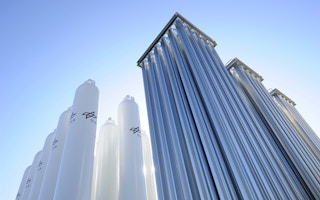Asia Pacific (APAC) is responsible for the majority of the world’s energy consumption. The region accounts for US$31.8 trillion of gross domestic product (GDP) collectively, and to secure energy needed for economic development while reducing its carbon emissions is a tough balancing act.
To continue reading, subscribe to Eco‑Business.
There's something for everyone. We offer a range of subscription plans.
- Access our stories and receive our Insights Weekly newsletter with the free EB Member plan.
- Unlock unlimited access to our content and archive with EB Circle.
- Publish your content with EB Premium.
All APAC nation states have signed the 2015 Paris Agreement, committing to limit global warming to well below 2°C and pursuing efforts to limit it to 1.5°C. It is a complex target to navigate and requires a long-term clean energy source.
Green hydrogen has emerged as a game changer for achieving climate neutrality. It represents a key component in the decarbonisation journey as other forms of hydrogen production are carbon intensive. Green hydrogen is produced using clean energy from surplus renewable energy sources – solar or wind power – to split water into hydrogen and oxygen atoms through an electrolysis process. The resulting hydrogen gas can be burned in a clean way without creating any new emissions. Green hydrogen can also be transported by modifying our existing natural gas infrastructure for various end uses.
Yet, given the diverse considerations and networks within the region’s energy ecosystem, to usher in APAC’s green hydrogen era will require a different approach. How we produce, transport, and consume green hydrogen needs to be broader, encompass more stakeholders, and all these will require a collaborative effort. Optimising green hydrogen production will rely on visibility across the value chain. Ultimately, it will be down to data connectivity that will make the real difference for APAC.
Navigating complexities
According to a 2022 report co-authored by the Hydrogen Council and McKinsey & Company, companies around the world announced US$25 billion worth of investments in hydrogen infrastructure. These investments – through to 2030 – encompass refuelling stations, pipelines, terminals, and ships. About half of these target the APAC region.
This represents a serious commitment to hydrogen, particularly within the region. The investments also reveal the complexities involved in revamping APAC energy infrastructure networks to meet future green hydrogen requirements.
For example, pipeline hydrogen injections are currently part of national hydrogen strategies by countries such as Japan, South Korea, and Australia. To avoid major modifications to existing natural gas pipelines, hydrogen is blended in low concentrations with natural gas for power and heating needs. To accommodate higher hydrogen concentrations, network modifications would be necessary – such as replacing steel pipes with polymer pipes, or even replacing compressors altogether.
And to account for the potential shortfall of hydrogen supplied, externally sourced imports of green hydrogen would be necessary. By producing green hydrogen through electrolysers, energy generated by wind or solar power projects can be stored and transported to regions with lower production and higher demand. Yet, in reality, it involves navigating competing immediate needs – such as using hydrogen as an input source for renewables, steel, ammonia. Other factors such as fertiliser prices or regulated hydrogen reserve levels will influence the green hydrogen perspective. All of these reveal the complexities in the green hydrogen journey.
Data that breaks down barriers
Improving how green hydrogen is processed and ultimately used by the consumer will require extrapolating insights from existing plant projects, learning more about the yields from our most viable technologies, and deciding the role that utilities companies will play in tomorrow’s green hydrogen ecosystem.
These complexities and interdependencies across the extended value chain makes a compelling case for a new data infrastructure model, one that connects all stakeholders, plant infrastructure, and process chains through enterprise-level visibility and real-time status. Through a strong data-driven approach, the region can collectively progress based on its unique traits and circumstances.
We are already collecting and measuring operational data of plant infrastructure through embedded Internet-of-Things (iOT) devices. These data inputs are used to recreate digital-twin models of plants to optimise operations and yield improved plant performance. Across APAC, individual industrial plants are incorporating digital twins into their daily operations.
Green hydrogen and green hydrogen-based fuels are among the most significant ways that industries can reduce carbon emissions, drive energy efficiency and make energy production less harmful to the environment.
APAC’s energy ecosystem is making steady progress and the green hydrogen era will test our abilities to make decisions amid complexities and competing objectives. Data-driven insights will be key to this journey. Engineering advancements today have to be matched with a unified common data infrastructure to create positive outcomes for everyone. Through optimised data flows and accessible data across the value-chain, the region can win in the green hydrogen era.
Emon Zaman is senior vice-president, Asia Pacific at Schneider Electric-owned software company AVEVA.











